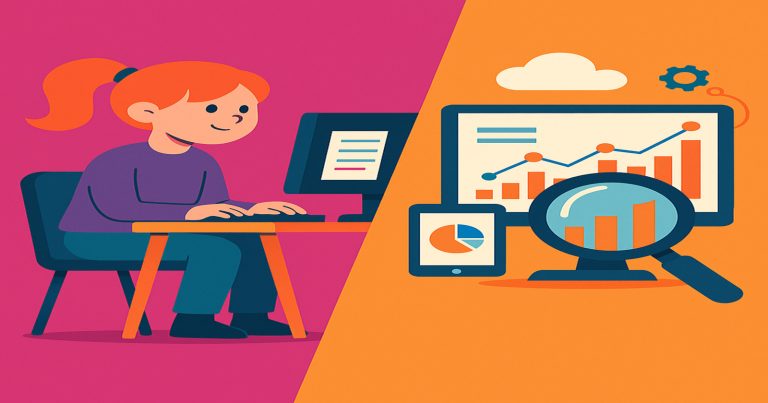Understanding the difference between primary and secondary data is essential for students, researchers, and professionals engaged in decision-making and research. Each data type has strengths and applies to a specific research. This article will give detailed definitions, advantages, disadvantages, and applications of both data types.
What is Primary Data?
Primary data refers to original information gathered firsthand by a researcher for a particular study. It is fresh, unique, and directly related to the research objectives. Let’s dive deeply into its critical importance in structured research and analytics.
Meaning and Characteristics of Primary Data
Primary data are data collected by the researcher directly from the source. That means the information is clean and has not been manipulated or interpreted by someone else. It uses surveys, interviews, experiments, or observations to answer specific research questions.
This kind of data benefits deep studies because it is specific, reliable, and original. It provides the most relevant insights since it was generated for exact research intents. However, it takes time and resources to collect.
Surveys and Questionnaires
Surveys generate large-scale responses from the target groups in a structured way. This may include multiple-choice or open-ended questions based on the nature of the data required.
Surveys allow for statistical analyses and are suitable for quantitative research. They are instrumental in market research or behavioral studies examining numerical trends.
Interviews
Interviews occupy a dedicated time slot for face-to-face (or virtual) conversation aimed at obtaining detailed opinions and information. They are usually unstructured and thus allow for an in-depth exploration of the subject. Interviews are frequently used to gain qualitative insights in social sciences, human resources, and product design research. Interviews are very time-consuming, and results may be subject to interviewer bias.
Experiments
Experiments deal with manipulating variables to assess the effects of conditional changes. This method is strictly controlled and produces high-quality data. This primary data collection mode is prevalent in scientific, psychological, or economic studies. It is considered to give precise estimates, although the artificial nature of the setting usually fails to capture real-life behavior.
Observations
Observational research involves watching and recording behaviors or events in a natural or controlled setting. It is a passive method and doesn’t involve direct interaction. This is particularly helpful when studying non-verbal cues, consumer habits, or natural behaviors. It captures data in real time but is limited to only what is visible.
Focus Groups
A focus group includes a small set of people discussing a topic under a facilitator’s guidance. The group interaction provides diverse opinions in a short time. It’s a powerful tool in product development and brand positioning. Yet, it may not represent the entire target population due to its limited size.
What is Secondary Data?
Secondary data is information collected by someone else for a different purpose. It is already available, processed, and stored in various formats. Here’s why it plays a significant role in quick and cost-effective research.
Meaning and Characteristics of Secondary Data
Secondary data includes existing information that has been gathered and published by government bodies, academic institutions, private firms, or online platforms. This data was not collected specifically for your current research but can still be extremely useful. It’s often available in books, articles, government records, databases, and websites. Researchers save time and money using secondary data, though it may not perfectly align with specific research needs.
Actual Published Research and Reports
These are academic and industry papers with an exhaustive investigation of a topic. Most of them are peer-reviewed, thus worthy of credibility and fact richness. Researchers have a ready-made collection of analyzed material to support or contradict their findings. The problem arises when the existing material is dated or not entirely matched to the current objective.
Government and Institutional Reports
The government and large institutions publish statistics, census reports, and public records regularly. They hold credibility and cover significant populations or many indicators in the economy. Such secondary data are helpful for demographic or economic studies. However, their access might be subscription-specific or by a particular region.
Online Databases and Digital Portals
They include Google Scholar, Research Gate, Statista, etc.; thousands of data sets or research findings are piled in thousands and are thus found within these platforms. Primary sources of secondary data, too. This data would have included qualitative and quantitative data across numerous domains. However, the disadvantage of these platforms is that data quality may vary and thus needs verification before it can be relied upon.
News Articles and Magazines
The journalistic source often highlights trends, sentiments, and real-time affairs. This helps researchers correlate context, especially in social sciences. This means that the media content may lack in-depth or academic intensity, and one should always consider the source’s bias before using the data.
Difference Between Primary and Secondary Data
Both types of data serve different purposes and have specific characteristics. These two forms of data are often compared using several vital parameters to see how they fit into the research workflow.

Purpose and Relevance
Primary data are those collected primarily for a specific research purpose; hence, they directly relate to the stated objective. Conversely, secondary data are collected for other purposes, and their relevance primarily depends on how closely their objectives match present research objectives. For instance, a market survey done by a firm to launch a product constitutes primary data, whereas the government census is secondary data adopted by several entities.
Time and Cost Efficiency
Primary data consume more time, labor, and funds since a researcher develops the property entirely. In contrast, secondary data is inexpensive and fast because it is already compiled. This makes secondary data more appropriate for exploratory or pilot studies and primary data for detailed or precision studies.
Accuracy and Specificity
Because primary data are customized to a particular research purpose, they are usually more accurate and specific. Secondary data tend to be generalized and less aligned, which, in turn, can affect precision in some studies. However, if it turns out to be secondary data from reputable institutions or peer-reviewed publications, it could be quite credible.
Flexibility and Control
Primary data give the maximum control over variables and collection methodologies. Secondary data give none, thus constraining the researchers from customizing or interpreting it in a context beyond the original one. For instance, during a focus group, you can change the questions as you go along, which is impossible with secondary data.
| Aspect | Primary Data | Secondary Data |
| Definition | Data collected firsthand by the researcher specifically for the current study. | Data already collected by someone else for a different purpose, reused in the current research. |
| Source | Direct from original source via surveys, interviews, observations, experiments, etc. | Existing sources such as books, journals, reports, databases, government publications. |
| Purpose | Collected to meet the specific objectives of a particular research problem. | Originally collected for a separate purpose but adapted for current research. |
| Time Required | Time-intensive as it involves planning, collection, and processing of raw data. | Quick to access since the data is already available in published or stored format. |
| Cost | Expensive due to fieldwork, manpower, tools, and data processing. | Cost-effective or free; often publicly accessible or part of subscriptions. |
| Control Over Data | Complete control over what, how, when, and where data is collected. | No control; researcher is bound by the format, scope, and variables of pre-existing data. |
| Accuracy and Reliability | Highly accurate and specific if properly collected; tailored to research needs. | Accuracy depends on the credibility of the original source and context of the data. |
| Format and Structure | Raw and unstructured initially; requires analysis and interpretation. | Usually well-organized, cleaned, and formatted; ready for immediate analysis. |
| Flexibility | Flexible; researcher can modify tools and questions during data collection. | Inflexible; confined to what has already been recorded and published. |
| Scope and Coverage | Limited to the sample size and reach defined by the current research. | Broad coverage; often includes national, regional, or historical data. |
| Examples | Surveys, interviews, field studies, lab experiments, direct observations. | Census reports, academic journals, government databases, online statistical tools. |
| Usefulness | Most useful when fresh, accurate, and customized data is essential. | Most useful for background research, hypothesis building, and exploratory studies. |
| Update Frequency | Updated on demand based on researcher’s timeline. | May be outdated; depends on when it was last collected and published. |
| Bias and Error Control | Researcher can minimize bias through careful design and execution. | Potential bias from original data collectors; may carry errors or outdated views. |
| Analysis Depth | Deeper analysis possible due to alignment with specific objectives. | Analysis limited to available variables and formats in the existing data. |
Pros and Cons of Primary Data and Secondary Data
Every form of data has its attributions and downfalls. It helps one choose the best type to suit their study purpose if these are understood.
Advantages of Using Primary Data
The data is collected specifically for use in the research, resulting in highly accurate and fresh insights into the information. The researcher can design the methods according to their precise need and maintain data quality. Data is trustworthy because of originality and control, and it further opens doors to new insights in previously untouched or unexplored areas.
Disadvantages of Primary Data
The main drawback of primary data is that it is costly and time-consuming to collect. This might involve hiring surveyors, developing digital tools, or ethical clearances. This makes it less feasible for smaller studies or those operating under a time constraint. Methodological errors may occur from inexperienced methodology researchers.
Primary Data and Secondary Data Difference FAQs
1. What is the main distinction between primary and secondary data?
Primary refers to data collected directly by the researcher, while secondary refers to data collected previously by another individual for other purposes.
2. Which data type is more dependable in scientific research?
Primary data is more reliable as it is specific and collected under controlled conditions, thus reducing errors and bias.
3. Why is secondary data so popular for exploratory research?
Quick and inexpensive, when paired with background information, secondary data usually provides the basis needed to generate new hypotheses.
4. Can both data types be used in a single research project?
Yes. Combining two kinds of data makes the analysis better, and the insights are balanced. This strengthens your conclusions.
5. How do I guarantee the quality of secondary data?
Validate accuracy and relevancy for the consumer by checking for the source’s credibility, publication date, and intent of the original research.


